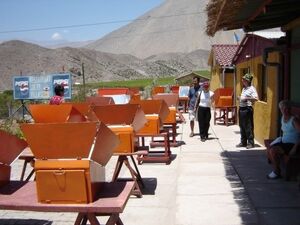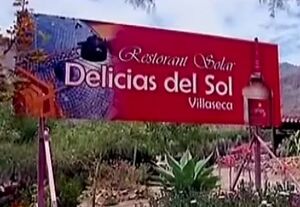Paul Hedrick (talk | contribs) m (→See also) |
Tom Sponheim (talk | contribs) Tag: sourceedit |
||
| (9 intermediate revisions by 2 users not shown) | |||
| Line 1: | Line 1: | ||
| + | {{GoogleTranslateLinks}} |
||
| + | |||
| + | {{Updated|12|29|12}} |
||
[[File:Delicias_del_Sol_signage,_12-29-12.jpg|right|300px]] |
[[File:Delicias_del_Sol_signage,_12-29-12.jpg|right|300px]] |
||
[[Image:Villaseca_solar_restaurant.jpg|thumb|right|300px|The [[Delicias del Sol]] in Villaseca,[[Chile]].]] |
[[Image:Villaseca_solar_restaurant.jpg|thumb|right|300px|The [[Delicias del Sol]] in Villaseca,[[Chile]].]] |
||
| Line 5: | Line 8: | ||
With the help of a $20,000USD grant from the United Nations Development Program, the restaurant followed soon after the association was formed. This energy-efficient success is particularly well-suited to the aptly named 'Villaseca' or 'Dry Town' community. It receives approximately 310 days of sunshine a year. [[fuelwood|Fuelwood]] for wood-burning ovens is scarce in this arid region of Chile, and is increasingly more expensive. This makes the sun-powered ovens even more attractive to locals looking to save on fuel costs. |
With the help of a $20,000USD grant from the United Nations Development Program, the restaurant followed soon after the association was formed. This energy-efficient success is particularly well-suited to the aptly named 'Villaseca' or 'Dry Town' community. It receives approximately 310 days of sunshine a year. [[fuelwood|Fuelwood]] for wood-burning ovens is scarce in this arid region of Chile, and is increasingly more expensive. This makes the sun-powered ovens even more attractive to locals looking to save on fuel costs. |
||
| − | + | Juan Ibacache, President of the association, relates: " The original project wasn't to start a restaurant. The project that came from Santiago was for people to use solar ovens in their own homes. However, that same dream combined with the entrepreneurship of those involved, inspired us to show people what we were doing at home on a daily basis - cooking with solar energy. We wanted to show tourists what really can be done with a solar oven - saving energy, protecting the environment, preventing deforestation." |
|
With an initial seating capacity of sixteen, the solar restaurant now seats 120. Due to high demand, the restaurant has even teamed up with tour operators to arrange visits. |
With an initial seating capacity of sixteen, the solar restaurant now seats 120. Due to high demand, the restaurant has even teamed up with tour operators to arrange visits. |
||
==Articles in the media== |
==Articles in the media== |
||
| − | *'''December 2012:''' [http://ntdtv.org/en/news/world/asia/2012-12-10/chilean-solar-oven-restaurant-shines.html Chilean Solar Oven Restaurant Shines] |
+ | *'''December 2012:''' [http://ntdtv.org/en/news/world/asia/2012-12-10/chilean-solar-oven-restaurant-shines.html Chilean Solar Oven Restaurant Shines] - ''NTD Television'' |
| + | *'''December 2012: '''[http://www.solarnews.ph/lifestyle/food/2012/12/17/delicias-del-sol-chilean-resto-uses-solar-ovens#.UN9VNhyebG9 Delicias del Sol: Chilean resto uses solar ovens] - ''Solar News BETA'' |
||
==Audio and video== |
==Audio and video== |
||
| + | *{{NewJan16}}'''October 2010:''' |
||
| ⚫ | |||
| + | ::[[File:Chile's Solar Restaurant "Solar cuisine" -Panasonic ecoideasnet|thumb|none|400px|Located south of Santiago, this restaurant has cooked with solar heat since 1989. In the past, many people cut trees for cooking fuel, a practice that led to desertification. To preserve forests, the University of Chile started a project to support solar ovens for restaurants in rural areas. At Solar de Villaseca, 10 solar ovens serve up to 70 people a day. In Chile, the sun shines 300 days a year!]] |
||
| − | {{clr}} |
||
| + | |||
| + | *'''December 2010:''' |
||
| ⚫ | |||
| + | |||
==See also== |
==See also== |
||
*[[Delicias del Sol]] |
*[[Delicias del Sol]] |
||
*[[Solar restaurants and bakeries]] |
*[[Solar restaurants and bakeries]] |
||
| + | *[[Income generation]] |
||
| + | *[[Solar cooking for large groups]] |
||
==External links== |
==External links== |
||
| Line 23: | Line 33: | ||
[[Category:Solar restaurants and bakeries]] |
[[Category:Solar restaurants and bakeries]] |
||
[[Category:Chile]] |
[[Category:Chile]] |
||
| + | [[Category:Verified active 2016]] |
||
Revision as of 19:04, 19 January 2016
|
Last edited: 29 December 2012
|

The Delicias del Sol in Villaseca,Chile.
The Association of Solar Artisans of Villaseca operates the Delicias del Sol restaurant in the village of Villaseca, Chile. Now in its twelfth year of operation in 2012, the local establishment is a collective made up of twenty-five partners from the region. Solar ovens were originally introduced to the village as a trial project from the University of Chile and the Institute for Nutrition and Food Technology. It was done to see if they could get people to use solar energy at home.
With the help of a $20,000USD grant from the United Nations Development Program, the restaurant followed soon after the association was formed. This energy-efficient success is particularly well-suited to the aptly named 'Villaseca' or 'Dry Town' community. It receives approximately 310 days of sunshine a year. Fuelwood for wood-burning ovens is scarce in this arid region of Chile, and is increasingly more expensive. This makes the sun-powered ovens even more attractive to locals looking to save on fuel costs.
Juan Ibacache, President of the association, relates: " The original project wasn't to start a restaurant. The project that came from Santiago was for people to use solar ovens in their own homes. However, that same dream combined with the entrepreneurship of those involved, inspired us to show people what we were doing at home on a daily basis - cooking with solar energy. We wanted to show tourists what really can be done with a solar oven - saving energy, protecting the environment, preventing deforestation."
With an initial seating capacity of sixteen, the solar restaurant now seats 120. Due to high demand, the restaurant has even teamed up with tour operators to arrange visits.
Articles in the media
- December 2012: Chilean Solar Oven Restaurant Shines - NTD Television
- December 2012: Delicias del Sol: Chilean resto uses solar ovens - Solar News BETA
Audio and video
- October 2010:
Chile's Solar Restaurant "Solar cuisine" -Panasonic ecoideasnet
Located south of Santiago, this restaurant has cooked with solar heat since 1989. In the past, many people cut trees for cooking fuel, a practice that led to desertification. To preserve forests, the University of Chile started a project to support solar ovens for restaurants in rural areas. At Solar de Villaseca, 10 solar ovens serve up to 70 people a day. In Chile, the sun shines 300 days a year!
- December 2010:
Restaurant's Ovens Powered by the Sun
The Delicias del Sol



